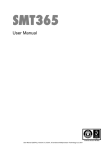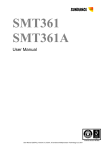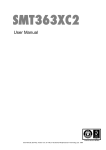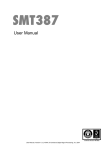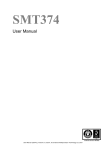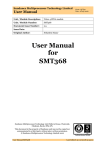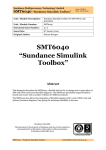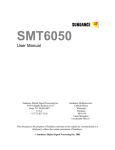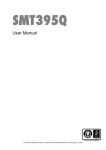Download SMT365e User Manual - Sundance Multiprocessor Technology Ltd.
Transcript
SMT365E User Manual User Manual (QCF42); Version 3.0, 5/2/01; © Sundance Multiprocessor Technology Ltd. 2001 Version 2.1 Page 2 of 26 SMT365e User Manual Revision History Date Comments Engineer Version 18/07/02 First rev, based on 361 GP 1.0.0 06/01/03 User manual updated, 2 SHBs YC 1.0.1 16/01/03 Changed flash to 4Mbyte GP 1.0.2 20/01/03 Added FPGA pin-out GP 1.0.3 31/01/03 Changed CPLD hdr pin-out. GP 1.0.4 Set DSP clk=600, emif clk=100 24/02/03 No more SDBs clock selection JPA 1.0.5 17/03/03 Added location of SDBs on the board. JPA 1.0.6 Updated FPGA memory mapping. 24/04/03 Updated Data Sheets (Hyperlinks) section JPA 1.0.7 19/09/03 Updated Data Sheets (Hyperlinks) section JPA 1.0.8 Updated Reprogramming chapter 09/08/05 Update: the user manual supports the new firmware implementation V3.0 (XC2V6000) and the firmware V1.0 (XC2V8000) SM 2.0 25/01/06 Errata: Flash ROM access SM 2.1 16/02/06 Update: the user manual supports the new firmware implementation for 2xSDBs, 32bits V3.12 (XC2V6000) AL 2.2 Version 2.1 Page 3 of 26 SMT365e User Manual Table of Contents Revision History ....................................................................................................... 2 Contacting Sundance............................................................................................... 4 Notational Conventions ........................................................................................... 5 DSP ........................................................................................................................ 5 SDB ........................................................................................................................ 5 SHB ........................................................................................................................ 5 Register Descriptions .............................................................................................. 5 Outline Description .................................................................................................. 6 Intended Audience ................................................................................................... 6 Block Diagram .......................................................................................................... 7 Architecture Description.......................................................................................... 8 DSP ............................................................................................................................ 8 Boot Mode............................................................................................................... 8 EMIF Control Registers........................................................................................... 9 SDRAM ................................................................................................................... 9 FLASH .................................................................................................................. 10 Virtex FPGA............................................................................................................. 11 Version control ...................................................................................................... 11 Firmware versions.................................................................................................. 11 Reprogramming the firmware and boot code ...................................................... 11 Comports................................................................................................................. 12 SHB .......................................................................................................................... 12 Global bus ............................................................................................................... 12 LED Setting ............................................................................................................. 13 LED Register......................................................................................................... 13 CONFIG & NMI ........................................................................................................ 14 Config Register ..................................................................................................... 14 Timer........................................................................................................................ 15 Timer Control Register .......................................................................................... 15 IIOF interrupt........................................................................................................... 16 Code Composer...................................................................................................... 17 Version 2.1 Page 4 of 26 SMT365e User Manual Application Development....................................................................................... 17 SMT6400 .............................................................................................................. 17 3L Diamond........................................................................................................... 17 SMT6500 .............................................................................................................. 17 Operating Conditions ............................................................................................. 18 Safety.................................................................................................................... 18 EMC ...................................................................................................................... 18 General Requirements .......................................................................................... 18 Power Consumption.............................................................................................. 18 Connector Positions .............................................................................................. 19 Serial Ports & Other C60 I/O .................................................................................. 20 FPGA and CPLD JTAG ........................................................................................... 20 Virtex Memory Map................................................................................................. 21 SHB pin-out........................................................................................................... 23 SHB generic pin-out .............................................................................................. 23 FPGA PROG Pin Control (JP7 connector)............................................................ 24 DSP Boot Mode Control (JP6 connector).............................................................. 24 Bibliography............................................................................................................ 25 INDEX ...................................................................................................................... 26 Contacting Sundance You can contact Sundance for additional information by login onto the Sundance support forum. Version 2.1 Page 5 of 26 SMT365e User Manual Notational Conventions DSP The terms DSP, C64xx and TMS320C64xx will be used interchangeably throughout this document. SDB The term SDB will be used throughout this document to refer to the Sundance Digital Bus interface. SHB The term SHB will be used throughout this document to refer to the Sundance Highspeed Bus interface. Register Descriptions The format of registers is described using diagrams of the following form: 31–24 23–16 15–8 7–0 R,00000000 R,10000000 OFLAGLEVEL R,00000000 RW,10000000 The digits at the top of the diagram indicate bit positions within the register and the central section names bits or bit fields. The bottom row describes what may be done to the field and its value after reset. Shaded fields are reserved and should only ever be written with zeroes. R Readable by the CPU W Writeable by the CPU RW Readable and writeable by the CPU Binary digits indicate the value of the field after reset Version 2.1 Page 6 of 26 SMT365e User Manual Outline Description The SMT365 is a DSP module, size 2 TIM offering the following features: TMS320C6416 processor running at 600MHz Six comports 256MB of SDRAM (100MHz) 4MB of Flash ROM Global Bus connector 6 SHB connectors for high-speed data transfer Intended Audience There are two existing versions of the firmware for the SMT365e. For each of the versions of the different firmware is loaded in the FPGA: - Firmware version 1.1 or - Firmware version 1.2 This user manual covers the version 1.2 of the firmware for the SMT365e implemented with the model described in the SMT6500 help file. Refer to section Firmware versions. Version 2.1 Page 7 of 26 SMT365e User Manual Block Diagram The following drawing shows the block diagram of the SMT365e module. The main components of the SMT365e are: - A Texas Instruments DSP - One Xilinx FPGA Virtex-II device - 256MB of SDRAM 2x Comm-Ports/SDL 26 I/O pins JTAG Header X-Checker Header 4 LEDs & 4 I/O pins McBSP/Utopia/ GPIO FPGA Controller 171 pins 'C6416 DSP 525 pins 256Mbytes SDRAM 4x Comm-Port/SDL 52 I/O pins 360 pins Virtex-II, FF1152 824 I/O pins - Used 776 XC2V6000 1.5V Global Bus 74 I/O pins Sundance High-speed Bus 60-way Samtec x 6 Timer,& Control 15 I/O pins J1 Top Primary TIM Connector Comm-Port 0 & 3 DC-DC Converters for DSP and FPGA cores J3 Global Expansion Connector J2 Bottom Primary TIM Connector Comm-Port 1;2;5;4 Flash 4 LEDs + GPIO Oscillator Version 2.1 Page 8 of 26 SMT365e User Manual Architecture Description DSP The Texas Instruments DSP can run at up to 600MHz. The DSP is doted of 256MB of Synchronous DRAM (SDRAM). The DSP is a TMS320C6416 type. This is a fixed-point digital signal processor provided by Texas Instruments. The processor will run with zero wait states from internal SRAM. The internal memory is 1MB in size and can be partitioned between normal SRAM and L2 cache. An on-board crystal oscillator provides the clock used for the DSP which them multiplies this by twelve internally. Boot Mode The DSP is connected to the on-board flash ROM that contains the Sundance bootloader and the FPGA bitstream. Following reset, the DSP will automatically load the data from the flash ROM into its internal program memory at address 0 and then start executing from there. All this code is the Sundance bootloader, and it is made up of two parts: FPGA configuration and processor configuration. FPGA configuration uses data in the ROM to configure the FPGA. A processor configuration sets the processor into a standard state by writing into the DSP internal registers of the EMIF. Then it configures the FPGA from the data held in the flash ROM. The bootloader is executed. It will continually check the six comports until data appears on one of them. This will next load a program in boot format from this comport. Note that the bootloader will not read data arriving on other comports. Finally the control is passed to the loaded DSP application. The DSP will take approximately about 46s to configure the FPGA following reset, assuming a 600MHz clock. The external devices implemented in the FPGA (such as comports) must not be used during this configuration. It is safest to wait for the configuration to complete. Note that comports will appear to be "not ready" until the FPGA has been configured. The FPGA programming algorithm is not described here. It can be found in the boot code. Version 2.1 Page 9 of 26 SMT365e User Manual EMIF Control Registers The DSP has two external memory interfaces (EMIF) which are 64 bits wide and 16 bits wide. The DSP contains several registers that control the external memory interface (EMIF). A full description of these registers can be found in the DSP C6000 Peripherals Reference Guide. The standard bootstrap will initialise these registers to use the following resources: Memory space Resource Address range (EMIFA) Internal program memory 0x00000000 - 0x000FFFFF (1MB) CE0 SDRAM 0x80000000 - 0x8FFFFFFF CE1 Virtex 0x90000000 - 0x9FFFFFFF Memory space Resource Address range (EMIFB) CE0 Flash paging control 0x60000000 – 0x60000200 CE1 4MB Flash (1st half) 0x64000000 – 0x640FFFFF CE2 4MB Flash (2nd half) 0x68000000 – 0x680FFFFF CE3 FPGA Configuration control 0x6C000000 – 0x6C000002 SDRAM Memory space CE0 is used to access 256MB of SDRAM over EMIFA. The speed of the SDRAM is dependent on the processor variant. Using the C6416, the SDRAM will operate at 133MHz maximum. It operates at one sixth of the core clock speed. The EMIFA CE0 memory space control register should be programmed with the value 0x000000D0 (64 bits SDRAM). Version 2.1 Page 10 of 26 SMT365e User Manual FLASH A 4MB of Flash ROM is connected to the DSP in the EMIFB CE1 & CE2 memory spaces. The ROM holds boot code for the DSP, configuration data for the FPGA, and optional user-defined code. The EMIFB CE1 and CE2 space control registers should be programmed with the values 0x00000030 and 0xFFFFFF23 respectively. As the DSP only provides 20 address lines on its EMIFB, both CE1 & CE2 are used to access this device. This in itself allows the direct access to 2MB. A paging mechanism is used to select which half of the 4MB device is visible in this 2MB window. As the EMIFB CE1 & CE2 memory spaces alias throughout the available range, the flash device can be accessed using the address range 0x67E00000-0x681FFFFF. This gives a 2MB continuous memory space. Selecting the visible flash memory page (2 pages of 2MB) involves writing to the following addresses as shown (the data written is irrelevant): Address Flash page selected 0x60000000 Page 0 0x60000100 Page 1 The EMIFB CE0 memory space control register should be programmed with the value 0xFFF0C003. Version 2.1 Page 11 of 26 SMT365e User Manual Virtex FPGA The FPGA (Field Programmable Gate Array) is a Xilinx Virtex-II device XC2V6000. It implements the following communication resources: • Six Comport interfaces • Four 16-bit Sundance Digital Bus interfaces • One Global Bus interface Version control Revision numbers for both the boot code and FPGA firmware are stored in the Flash ROM during programming as zero-terminated ASCII strings. The SMT6001 utility can be used to display the version numbers of the bootloader and the FPGA data. Firmware versions The SMT6001 utility includes the latest version of the bootloader and the latest version of the FPGA data that implements the FPGA architecture described in the SMT6500 help file. Customers who wish to use the old firmware can obtain it from our support web forum. Reprogramming the firmware and boot code The contents of the flash ROM are managed using the SMT6001 utility. This includes the latest firmware and bootloader along with complete documentation on how to reprogram the ROM. The utility assumes that you have Code Composer Studio installed and that it has been configured correctly for the installed TIMs. The Sundance Wizard can help you with this. To confirm that the ROM has been programmed correctly, you should run the confidence test in the BoardInfo utility (SMT6300). Version 2.1 Page 12 of 26 SMT365e User Manual Comports The DSP has six comports, numbered 0 to 5. The addresses of the Comport registers are described in the SMT6400 help file. SHB The SMT365e has six SHB connectors, all of which are connected to the DSP to give 16-bit/32-bit SDB interfaces on two SHB connectors. These interfaces operate with a fixed clock rate of 100MHz. Note that the four other SHB connectors are not used. The following figure shows their localisation on the board: SDB2 SHB_B SDB3 SDB0 SHB_A SDB1 Global bus The SMT365e provides a single global bus interface. This is only accessible from the DSP. The addresses of the global bus registers are shown in the Virtex Memory Map, and are described in the SMT6400 help file. Version 2.1 Page 13 of 26 SMT365e User Manual LED Setting The SMT365e has 13 LEDs. One shows the FPGA configuration status and the other 4 are under DSP control. LED D6 always displays the state of the FPGA DONE pin. This LED is off when the FPGA is configured (DONE=1) and on when it is not configured (DONE=0). This LED should go on when the board is first powered up and go off when the FPGA has been successfully programmed (this is the standard operation of the boot code resident in the flash memory device). If the LED does not light at power-on, check that you have the mounting pillars and screws fitted properly. If it stays on, the DSP is not booting correctly, or is set to boot in a non-standard way. Four of the remaining LEDs can be controlled with the LED register (D11, D12, D13, D14). Writing 1 will illuminate the LED; writing 0 will turn it off. Note that the LEDs D7-D10 are not used. LED Register (0x900D0000) 31–4 7 RW,0 6 RW,0 5 RW,0 4 RW,0 3 2 1 0 LED D11 LED D12 LED D13 LED D14 RW,0 RW,0 RW,0 RW,0 The four remaining LEDs (D2-5) are connected to the C60’s GPIO pins 12-15. Version 2.1 Page 14 of 26 SMT365e User Manual CONFIG & NMI The TIM specification describes the operation of an open-collector type signal CONFIG that is driven low after reset. This signal, on a standard C4x based TIM, is connected to the processor’s IIOF3 pin. On the SMT365, the CONFIG signal is asserted after power on, and can be released by writing the value (1<<6) to the config register. Conversely, CONFIG may be reasserted by writing 0 to this bit. It is not possible for software to read the state of the CONFIG signal. The NMI signal from the TIM connector can be routed to the DSP NMI pin. WARNING: Several software components include code sequences that assume setting GIE=0 in the DSP CSR will inhibit all interrupts; NMI violates that assumption. If an NMI occurs during such code sequences it may not be safe to return from the interrupt. This may be particularly significant if you are using the compiler’s software pipelining facility. Config Register 31–8 Field CONFIG NMI 7 6 NMI CONFIG Description 0 drive CONFIG low 1 tri-state CONFIG 0 Disconnect NMI from the DSP 1 Connect NMI from TIM to the DSP. Config and NMI DSP lines are described in the SMT6400 help file. 5–0 Version 2.1 Page 15 of 26 SMT365e User Manual Timer The TIM TCLK0 and TCLK1 signals can be routed to the DSP’s TOUT/TINP pins. The signal direction must be specified, together with the routing information in the timer control register. Timer Control Register Field 31–6 5 4 3–0 Reserved TCLK1 TCLK0 Reserved Description TCLK0 TCLK1 0 TIM TCLK0 is an input 1 Enable TIM TCLK0 as an output 0 TIM TCLK1 is an input 1 Enable TIM TCLK1 as an output If the TIM TCLKx pin is selected as an output, the DSP TOUTx signal will be used to drive it. The TIM TCLKx pin will always drive the DSP TINPx input. TCLK0EN C6x TOUT0 TINP0 TCLK0 FPGA The Timer control register is described in the SMT6400 help file. Version 2.1 Page 16 of 26 SMT365e User Manual IIOF interrupt The firmware can generate pulses on the external interrupt lines of the TIM. Only the interrupt line IIOF1 and IIOF2 are connected from/to the DSP and the HOST. • IIOF1 is connected from the DSP side to the HOST side: so, the DSP interrupts the HOST • IIOF2 is connected from the HOST side to the DSP side: so, the HOST interrupts the DSP The IIOF interrupt lines are described in the SMT6400 help file. Version 2.1 Page 17 of 26 SMT365e User Manual Code Composer This module is fully compatible with the Code Composer Studio debug and development environment. This extends to both the software and JTAG debugging hardware. The driver to use is the tixds64xx_11.dvr. CCS version 3.0 or later is required as the reprogramming utility (SMT6001) requires it. Troubleshooting Our Knowledge data base and FAQ sections may help you to resolve some known issues. Application Development Depending on the complexity of your application, you can develop code for SMT365 modules in several ways. SMT6400 For simple applications, the Sundance SMT6400 software support package (project examples) and its associated header files (SmtTim.h and ModSup.h) can suffice. The SMT6400 product is installed by the Sundance Wizard and it is free of charge. 3L Diamond This module is fully supported by 3L Diamond, which Sundance recommends for all but the simplest of applications. A SMT365e has to be declared as appropriate in configuration files as one processor of type: • SMT365E SMT6500 This is the support package for the FPGA. It may be used to develop your application in the FPGA of the module. Version 2.1 Page 18 of 26 SMT365e User Manual Operating Conditions Safety The module presents no hazard to the user. EMC The module is designed to operate within an enclosed host system that provides adequate EMC shielding. Operation within the EU EMC guidelines is only guaranteed when the module is installed within an appropriate host system. The module is protected from damage by fast voltage transients introduced along output cables from outside the host system. Short-circuiting any output to ground does not cause the host PC system to lock up or reboot. General Requirements The module must be fixed to a TIM40-compliant carrier board. The SMT365e TIM is in a range of modules that must be supplied with a 3.3V power source. In addition to the 5V supply specified in the TIM specification, these new generation modules require an additional 3.3V supply to be presented on the two diagonally-opposite TIM mounting holes. The lack of this 3.3V power supply should not damage the module, although it will obviously be inoperable; prolonged operation under these circumstances is not recommended. The SMT365e is compatible with all Sundance TIM carrier boards. It is a 5V tolerant module, and as such, it may be used in mixed systems with older TIM modules, carrier boards and I/O modules. Use of the TIM on SMT327 (cPCI) motherboards may require a firmware upgrade. If LED D6 on the SMT365e remains illuminated once the TIM is plugged in and powered up, the SMT327 needs the upgrade. The latest firmware is supplied with all new boards shipped. Please contact Sundance directly if you have an older board and need the upgrade. The external ambient temperature must remain between 0°C and 40°C, and the relative humidity must not exceed 95% (non-condensing). Power Consumption The power consumption of this TIM is dependent on the operating conditions in terms of core activity and I/O activity. The maximum power consumption is 10W. Version 2.1 Connector Positions Page 19 of 26 SMT365e User Manual Version 2.1 Page 20 of 26 SMT365e User Manual Serial Ports & Other C60 I/O The C60 contains various I/O ports. These signals are connected to a 0.1” pitch DIL pin header. The pin-out of this connector is shown here: P DR0 FSR0 DX0 FSX0 CLKR0 CLKX0 CLKS0 CLKS1 CLKX1 CLKR1 URA3 URA4 URA2 CLKS2 DX1 FSX1 GPIO8 UXA4 O L DR2 FSR2 DX2 FSX2 CLKR2 CLKX2 A R URA1 URA0 FSR1 DR1 UXA0 UXA3 UXA2 UXA1 URD0 URD1 URD2 URD3 URD4 URD5 URD6 URD7 URCLK URENB URCLAV URSOC UXD0 UXD1 UXD2 UXD3 UXD4 UXD5 UXD6 UXD7 UXCLK UXENB UXCLAV UXSOC NC GPIO9 GPIO10 GPIO11 GPIO12 GPIO13 GPIO14 GPIO15 V33 V33 TTL2 TTL3 GPIO0 GPIO1 GPIO2 GPIO3 GPIO4 GPIO5 GPIO6 GPIO7 GND GND TTL0 TTL1 I S A T I O N FPGA and CPLD JTAG The following shows the pin-outs for JP2 (CPLD) and JP3 (FPGA) JTAG connectors: Signal Pin Pin Signal V33 1 4 TMS TCK 2 5 TDO GND 3 6 TDI Version 2.1 Page 21 of 26 SMT365e User Manual Virtex Memory Map #define SMT365eCP0 (volatile unsigned int *)0x90000000 #define SMT365eCP1 (volatile unsigned int *)0x90008000 #define SMT365eCP2 (volatile unsigned int *)0x90010000 #define SMT365eCP3 (volatile unsigned int *)0x90018000 #define SMT365eCP4 (volatile unsigned int *)0x90020000 #define SMT365eCP5 (volatile unsigned int *)0x90028000 #define SMT365eCP0_STAT (volatile unsigned int *)0x90004000 #define SMT365eCP1_STAT (volatile unsigned int *)0x9000C000 #define SMT365eCP2_STAT (volatile unsigned int *)0x90014000 #define SMT365eCP3_STAT (volatile unsigned int *)0x9001C000 #define SMT365eCP4_STAT (volatile unsigned int *)0x90024000 #define SMT365eCP5_STAT (volatile unsigned int *)0x9002C000 #define SMT365eGB_STAT (volatile unsigned int *)0x90034000 #define SMT365eSDB_STAT (volatile unsigned int *)0x90038000 #define SMT365eSTAT (volatile unsigned int *)0x9003C000 #define SMT365eSDBA (volatile unsigned int *)0x90040000 #define SMT365eSDBB (volatile unsigned int *)0x90050000 #define SMT365eSDBC (volatile unsigned int *)0x90060000 #define SMT365eSDBD (volatile unsigned int *)0x90070000 #define SMT365eSDBA_STAT (volatile unsigned int *)0x90048000 #define SMT365eSDBB_STAT (volatile unsigned int *)0x90058000 #define SMT365eSDBC_STAT (volatile unsigned int *)0x90068000 #define SMT365eSDBD_STAT (volatile unsigned int *)0x90078000 #define SMT365eSDBA_INPUTFLAG (volatile unsigned int *)0x90044000 #define SMT365eSDBB_INPUTFLAG (volatile unsigned int *)0x90054000 #define SMT365eSDBC_INPUTFLAG (volatile unsigned int *)0x90064000 #define SMT365eSDBD_INPUTFLAG (volatile unsigned int *)0x90074000 #define SMT365eSDBA_OUTPUTFLAG (volatile unsigned int *)0x9004C000 #define SMT365eSDBB_OUTPUTFLAG (volatile unsigned int *)0x9005C000 #define SMT365eSDBC_OUTPUTFLAG (volatile unsigned int *)0x9006C000 #define SMT365eSDBD_OUTPUTFLAG (volatile unsigned int *)0x9007C000 #define GLOBAL_BUS (volatile unsigned int *)0x900A0000 #define GLOBAL_BUS_CTRL (volatile unsigned int *)0x90080000 #define GLOBAL_BUS_START (volatile unsigned int *)0x90088000 #define GLOBAL_BUS_LENGTH (volatile unsigned int *)0x90090000 Version 2.1 Page 22 of 26 SMT365e User Manual #define SMT365eTCLK (volatile unsigned int *)0x900C0000 #define SMT365eTIMCONFIG (volatile unsigned int *)0x900C8000 #define SMT365eLED (volatile unsigned int *)0x900D0000 #define SMT365eINTCTRL4 (volatile unsigned int *)0x900E0000 #define SMT365eINTCTRL4_EXT (volatile unsigned int *)0x900E4000 #define SMT365eINTCTRL5 (volatile unsigned int *)0x900E8000 #define SMT365eINTCTRL5_EXT (volatile unsigned int *)0x900EC000 #define SMT365eINTCTRL6 (volatile unsigned int *)0x900F0000 #define SMT365eINTCTRL6_EXT (volatile unsigned int *)0x900F4000 #define SMT365eINTCTRL7 (volatile unsigned int *)0x900F8000 #define SMT365eINTCTRL7_EXT (volatile unsigned int *)0x900FC000 Version 2.1 Page 23 of 26 SMT365e User Manual SHB pin-out SHB generic pin-out QSH Pin number Hw CLK 1 2 D0 D1 3 4 D2 D3 5 6 D4 D5 7 8 D6 D7 9 10 D8 D9 11 12 D10 D11 13 14 D13 15 16 D14 D15 17 18 USERDEF0 USERDEF1 19 20 USERDEF2 USERDEF3 21 22 WEN REQ 23 24 ACK 25 26 27 28 29 30 31 32 33 34 35 36 CLK 37 38 D0 D1 39 40 D2 D3 41 42 D4 D5 43 44 D6 D7 45 46 D8 D9 47 48 D10 D11 49 50 D13 51 52 D14 D15 53 54 USERDEF0 USERDEF1 55 56 USERDEF2 USERDEF3 57 58 WEN REQ 59 60 ACK Hw0 QSH Pin number Hw1 Hw1 Hw0 Hw D12 D12 Note: Hw is a short for Half-word (i.e. 16-bit Word) This standard is implemented using SAMTEC QSTRIP 0.50mm Hi-speed connectors. Version 2.1 Page 24 of 26 SMT365e User Manual FPGA PROG Pin Control (JP7 connector) Jumper Position 1-2 2-3 Out PROG asserted continuously PROG asserted for the duration of RESET. PROG under control of DSP Can also be controlled by the DSP. DSP Boot Mode Control (JP6 connector) In DSP will boot from flash Out DSP will be set to boot from HPI Version 2.1 Page 25 of 26 SMT365e User Manual Bibliography 1. Sundance Help file 2. SMT6400 help file (DSP support package) and SMT6500 help file (FPGA support package) 3. TMS320C6000 Peripherals Reference Guide (literature number SPRU190) It describes common peripherals available on the TMS320C6000 digital signal processors. This book includes information on the internal data and program memories, the external memory interface (EMIF), the host port, multichannel-buffered serial ports, direct memory access (DMA), clocking and phase-locked loop (PLL), and the power-down modes. 4. TIM-40 MODULE SPECIFICATION Including TMS320C44 Addendum 5. SDB Technical Specification 6. SHB Technical Specification 7. TMS320C4x User's Guide (literature number SPRU063) It describes the C4x 32-bit fixed-point processor, developed for digital signal processing as well as parallel processing applications. Covered are its architecture, internal register structure, instruction set, pipeline, specifications, and operation of its six DMA channels and six communication ports. Software and hardware applications are included. 8. Xilinx Virtex-II datasheet 9. TMSC6416 datasheet Version 2.1 Page 26 of 26 SMT365e User Manual INDEX LED register · 13 A N Application Development · 17 Architecture Description · 8 Notational Conventions · 5 B O Bibliography · 25 Block Diagram · 7 Boot Mode · 8 Operating Conditions · 18 P C Power consumption · 18 Code Composer · 17 Comport · 12 CONFIG & NMI · 14 R Register Descriptions · 5 E EMIF Control Registers · 9 F Firmware Reprogramming · 11 Firmware versions · 11 Flash · 10 S SDRAM · 9 Serial Ports · 20 SHB · 12 SMT6400 · 17 SMT6500 · 17 T I Timer · 15 IIOF lines · 16 V L LEDs · 13 Version Control · 11 Virtex memory map · 21


























